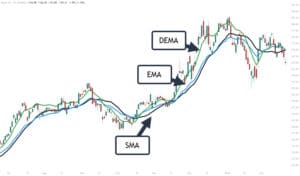In the fast-paced world of forex trading, technical indicators are like trusty compasses, guiding traders towards informed decisions. Among these indicators, moving averages (MAs) hold a prominent place. But within the MA family, there are variations catering to different analytical needs. Today, we delve into a specific type – the Range Weighted Moving Average (RWMA) – exploring its mechanics, applications, and how it can empower your forex trading strategies.
Beyond the Basics: Distinguishing RWMA from Traditional MAs
While standard moving averages like the Simple Moving Average (SMA) and Exponential Moving Average (EMA) offer valuable insights, they might not fully capture the significance of price movements within a specific period. The RWMA bridges this gap by incorporating the price range (the difference between the high and low) of each period as a weighting factor.
Imagine a standard 10-period moving average. Each of the past 10 closing prices contributes equally to the average. The RWMA, however, assigns greater weight to periods with a larger price range, reflecting the notion that significant price swings hold more importance in understanding the market sentiment.
Delving into the RWMA Formula
The calculation of the RWMA might seem complex at first glance, but it boils down to a logical application of weights. Here’s a breakdown:
- P(i): Price at period i (can be high, low, or closing price depending on the chosen variation)
- R(i): Price range for period i (High(i) – Low(i))
- n: Number of periods in the moving average
The RWMA for a given period i is calculated as:
RWMA(i) = Σ (P(i) * R(i)) / Σ R(i) for i = 1 to n
This formula essentially multiplies each price (P(i)) by its corresponding price range (R(i)) and then sums these products. The final sum is then divided by the sum of all price ranges within the chosen period (n). This weighted average reflects the influence of price volatility on the overall moving average.
RWMA in Action: Interpreting the Indicator
The RWMA line on your forex trading chart behaves similarly to other moving averages. It smooths out price fluctuations, revealing the underlying trend. However, due to the emphasis on price ranges, the RWMA reacts more dynamically to volatile market conditions.
- Upward Sloping RWMA: Similar to a traditional MA, an upward sloping RWMA suggests an uptrend. However, the emphasis on larger price ranges amplifies this trend, indicating potentially stronger buying pressure.
- Downward Sloping RWMA: A downward sloping RWMA signifies a downtrend. The focus on volatility reinforces this by highlighting the selling dominance during periods with wider price ranges.
- Flat RWMA: A flat RWMA suggests a consolidation phase or a period of indecision in the market. The lack of significant price swings translates into a relatively horizontal line.
Leveraging the RWMA for Strategic Forex Trading
Now that you understand the core principles of the RWMA, let’s explore how it can be integrated into your forex trading strategies:
- Identifying Trend Strength: The RWMA’s sensitivity to price volatility makes it adept at gauging trend strength. A steeper slope, coupled with increasing price ranges, indicates a potentially stronger trend with higher conviction.
- Confirmation of Breakouts: When a price decisively breaks above or below a rising/falling RWMA, it can signal a potential trend continuation. The emphasis on price range in the RWMA adds weight to such breakouts, suggesting a higher probability of the trend persisting.
- Volatility Filtering: The RWMA can act as a volatility filter, particularly when combined with other indicators. For instance, a rising RWMA alongside increasing Average True Range (ATR) values might suggest a strong uptrend with heightened volatility, potentially suitable for more aggressive traders.
Beyond the Basics: Variations and Considerations
The core RWMA formula offers a valuable foundation. However, there are variations worth exploring:
- High-Low RWMA: This variation uses the high and low prices of each period (P(i)) instead of closing prices. This can be useful for strategies focusing on price extremes within a timeframe.
- Customizable Weights: While the standard RWMA assigns weights based solely on price ranges, some platforms allow for user-defined weighting schemes. This enables advanced traders to tailor the indicator to their specific needs.
Overreliance on Volatility: The RWMA’s focus on volatility can be a double-edged sword. While it shines in trending markets, it might generate excessive noise during periods of choppy price action. Consider using additional tools like volatility filters to mitigate this effect.
Choosing the Right Parameters: The effectiveness of the RWMA depends on the chosen number of periods (n). A shorter period increases sensitivity to recent price action, making it suitable for identifying short-term trends. Conversely, a longer period smooths out volatility, revealing longer-term trends. Experiment with different periods to find what aligns with your trading style and timeframe.
Combining the RWMA with Other Indicators
The true power of the RWMA lies in its synergy with other technical indicators. Here are some effective combinations:
- Support and Resistance: The RWMA can act as dynamic support or resistance, especially during strong trends. Look for price reactions around the RWMA to confirm potential support/resistance zones.
- Momentum Indicators: Combining the RWMA with momentum indicators like the Relative Strength Index (RSI) or Stochastic Oscillator can provide a more comprehensive view of trend strength and potential turning points.
- Volume Confirmation: While the RWMA offers insights into volatility, high volume confirmation alongside a clear RWMA signal strengthens the validity of the trade idea.
Incorporating the RWMA into Your Trading Strategy
Here’s a practical example of how you can integrate the RWMA into your forex trading strategy:
- Identify the Trend: Analyze the overall market direction using higher timeframe charts and other technical indicators.
- Set the RWMA Parameters: Choose the appropriate number of periods for the RWMA based on your desired timeframe and trading style.
- Look for Confirmation Signals: Look for price action confirmations like breakouts above/below the RWMA or price reactions near the moving average line.
- Manage Risk: Always implement proper risk management techniques like stop-loss orders to limit potential losses.
The RWMA – A Dynamic Tool for Forex Traders
The RWMA offers a valuable addition to the forex trader’s arsenal. Its sensitivity to price volatility empowers traders to identify trends, assess their strength, and filter out market noise. Remember, the RWMA is most effective when combined with other technical tools and sound fundamental analysis. By understanding its strengths and limitations, you can leverage the RWMA to make informed trading decisions and navigate the dynamic world of forex.
Beyond the Scope: Further Exploration
The world of technical analysis is vast, and the RWMA is just one piece of the puzzle. Here are some avenues for further exploration:
- Advanced Moving Average Techniques: Explore variations like the Adaptive Moving Average (AMA) or Double Exponential Moving Average (DEMA) that adapt to changing market conditions.
- Volatility Measures: Delve deeper into volatility measurement tools like the Average True Range (ATR) and Bollinger Bands to refine your understanding of market behavior.
- Backtesting and Optimization: Utilize backtesting software to test the effectiveness of the RWMA in conjunction with other indicators under various market conditions.
By continuously learning and refining your technical analysis skills, you can elevate your forex trading game and navigate the ever-evolving market landscape with greater confidence.
Let’s Manage Your Forex Funds With Fx Pips Guru!
Fx Pips Guru is a forex fund management company managing client’s funds based on monthly profit share. Let’s do Live Chat with our experts.




